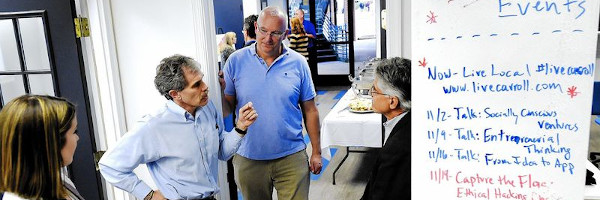MAGIC Smart Home Smart Community Project: Difference between revisions
No edit summary |
No edit summary |
||
| Line 7: | Line 7: | ||
| leader = Robert Wack | | leader = Robert Wack | ||
| email = rwack@magicinc.org | | email = rwack@magicinc.org | ||
| image = | | image = MAGIC1.jpg | ||
| imagecaption = MAGIC Smart Home Project | | imagecaption = MAGIC Smart Home Project | ||
| municipalities = The City of Westminster, MD | | municipalities = The City of Westminster, MD | ||
Revision as of 07:19, November 11, 2021
| MAGIC Smart Home Smart Community Project | |
|---|---|

| |
 MAGIC Smart Home Project | |
| Team Organizations | The Mid-Atlantic Gigabit Innovation Collaboratory (MAGIC); Target Community and Educational Services; Westminster Security Company; Skayl; EntryPoint Networks; The City of Westminster; Ting; Intel; Carroll Hospital; LifeBridge; Open Professional Group |
| Team Leaders | Robert Wack |
| Participating Municipalities | The City of Westminster MD |
| Status | Launched |
| Document | None |
Description
Install sensors and an in-home intelligent integration platform to demonstrate telemedicine features in a medically vulnerable group home setting; connected by Software Defined Networking (SDN) to other interested community partners utilizing the Westminster Fiber Network, to create the fundamental operational unit of a truly Smart Community.
Challenges
Global home healthcare market expected to grow from $220B to $350B in next decade. Hospital readmissions cost US hospitals upwards of $50B annually in the US. 65% of Medicare expenses for readmissions are considered avoidable. Every hospitalized patient risks developing Hospital Acquired Conditions (HAC) which cost an additional $373M annually. Unnecessary ED visits are estimated to be 60-80% of current volumes, representing billions of dollars in avoidable expenditures. Internet based home health care is growing rapidly. However, threats to the security, integrity, and privacy of web-based solutions are also growing.
Solutions
In home intelligence using sensor arrays and intelligent integration platform to analyze date, generate alerts, and create solutions locally. Software Defined Networking (SDN) to implement ad hoc network connections only to those parties with a need for a specific type of information, only when needed, for the required security, stability, and privacy to be HIPAA compliant and clinically effective. Integration of capabilities across the community to diverse users to begin the process of creating a truly Smart Community.
Major Requirements
A collaboration group of private industry, local non-profits, and the City of Westminster are working to use the Westminster Fiber Network to create the Smart Home Pilot project. A local non-profit delivering residential services to medically and behaviorally fragile adults with intellectual disabilities provided two homes as the pilot locations. Team members are deploying sensing technologies, an integration platform to create an intelligent in-home environment, and SDN to link parties across the community.
- Phase 1 – creation of fiber connections to demo home locations (in process)
- Phase 2 - installation of intrusion detection, integration platform, and SDN to initial locations.
- Phase 3 – implementation of efficiencies and process improvements for in-house staff using integration platform.
- Phase 4 - implementation of initial biometric and physiologic sensors for collection of clinically relevant and useful data for medical management.
- Phase 5 – Expansion of networked parties to include local hospital, care management resources, and other interested parties.
- Phase 6 – expansion to other communities.
Performance Targets
| Key Performance Indicators (KPIs) | Measurement Methods |
|---|---|
|
|
Standards, Replicability, Scalability, and Sustainability
- The project will incentivize and require collaboration across multiple organizations on technical, operational, and administrative issues.
- The technical solutions, workflows, and collaborative agreements created during the projects can become templates for similar projects in other communities.
- The project is lead and managed by local non-profits with limited resources and addresses a national problem that at its foundation is driven by resource constraints. All solutions will be measured against criteria of cost efficiency, effectiveness, scalability, and sustainability. Technical sophistication and novelty are very low priorities.
Cybersecurity and Privacy
Impacts
- Increased cost efficiency for health care utilization by clients of Pilot Project homes
- increased operational efficiencies of services provided in homes
- new investments in the Westminster community by team members
- increased national awareness of Westminster Fiber Network and smart home initiatives
- increased attention to and investments in telemedicine in the Westminster community to improve outcomes and the efficiency of healthcare resource utilization
- demonstration of technologies and processes to solve problems in a multi-billion dollar global marketplace
Demonstration/Deployment
- Phase I Pilot/Demonstration:
- project team assembled - done
- resource commitments established – done
- collaborative agreement formulated and implemented – in process
- infrastructure construction and installation – in process
- regular planning meetings – in process
- Phase II Deployment:
- installation of fiber (Phase 1) – complete
- installation of initial sensors (Phase 2) – complete
- operational efficiencies (Phase 3) - in process
- physiologic sensors (Phase 4) – planning underway, possible partial installation